Effect of recombinant human growth hormone and interferon gamma on hepatic collagen synthesis and proliferation of hepatic stellate cells in cirrhotic rats
Chengdu, China
Effect of recombinant human growth hormone and interferon gamma on hepatic collagen synthesis and proliferation of hepatic stellate cells in cirrhotic rats
Yong-Hua Chen, Bing-Qing Du, Zhen-Jiang Zheng, Guang-Ming Xiang, Xu-Bao Liu and Gang Mai
Chengdu, China
BACKGROUND: Fibrosis plays a key role in the development of liver cirrhosis. In this study, we investigated the effect of growth hormone and interferon gamma on hepatic collagen synthesis and the proliferation of hepatic stellate cells in a cirrhotic rat model.
METHODS: Cirrhosis was induced in rats using carbon tetrachloride. Rats were simultaneously treated with daily subcutaneous injections of recombinant human growth hormone or interferon gamma combined with recombinant human growth hormone. The control group was given saline. The relative content of type I and type IV collagen was assessed by indirect immunofluorescence analysis. Activated hepatic stellate cells were prepared from cirrhotic rats. The 3-(4, 5-dimethyl-2-thiazolyl)-2, 5-diphenyl-2H-tetrazolium bromide (MTT) method was used to assess the effects of recombinant human growth hormone and interferon gamma on these cellsin vitro.
RESULTS: Both qualitative and quantitative analysis showed that type I and type IV collagen secretion increased with time after recombinant human growth hormone administration and was significantly higher than control and recombinant human growth hormone combined with interferon gamma administration.In vitro, recombinant human growth hormone significantly stimulated hepatic stellate cell proliferation in a concentration-dependent manner (10-3-10-1mg/100 μL), andinterferon gamma (10-2-10-1μg/100 μL) significantly inhibited their growth compared to the control group. Interferon gamma combined with recombinant human growth hormone eliminated this growth-promoting effect to a certain degree in a concentration-dependent manner (10-1μg/100 μL,P<0.05, 10-2-10-3μg/100 μL,P>0.05) and a time-dependent manner (P<0.05).
CONCLUSIONS: Recombinant human growth hormone increased collagen secretion in cirrhotic ratsin vivoand promoted the proliferation of hepatic stellate cells from cirrhotic ratsin vitro. It is possible that concurrent interferon gamma therapy can offset these side-effects of recombinant human growth hormone.
(Hepatobiliary Pancreat Dis Int 2012;11:294-301)
growth hormone; interferon gamma; hepatic stellate cell; liver cirrhosis; collagen
Introduction
Liver cirrhosis is a consequence of chronic liver damage that is commonly associated with a catabolic state[1]and constitutes a major worldwide health-care burden. The etiology of the catabolic state is ill-defined,[2]and nutritional supplementation does little to correct it.[3]The growth hormone/insulin-like growth factor (GH/IGF) axis is unbalanced in patients with liver cirrhosis, and this may contribute to the associated malnutrition.[2]Two common features in human cirrhosis are low levels of circulating insulin-like growth factor I (IGF-I)[4]and growth hormone (GH) resistance.[5]Animal studies suggest that disruption of the GH/IGF-I axis severely aggravates liver fibrosis.[6]
GH is an anabolic agent that has been shown to decrease some of the deleterious effects of hypermetabolism. Recombinant human GH replacement therapy can overcome GH resistance and increase serum IGF-I[7]and albumin, and subsequently improve survival in adult patients with chronic liver disease.[8,9]Previous research as to whether GH promotes fibrosis is controversial. Studies on GH have shown a significant promotion of new collagen accretion in dense fibrous connective tissues[10]and increased bursting strength and collagen content in pregnant rat uterine incisions.[11]A positive effect of supra-physiological doses of GH seems to be the stimulation of collagen synthesis,[12]although other studies have shown that GH attenuates interstitial fibrosis.[13,14]Whether GH promotes collagen secretion in liver cirrhosis is unknown; thus, our primary hypothesis is that recombinant human GH promotes collagen synthesis in a cirrhotic rat model. Interferon gamma (IFN-γ) has been identified as an inhibitor of extracellular matrix (ECM) synthesis.[15]In liver fibrosis models, IFN-γ application has been successfully implemented with few side-effects.[16]Given these strong indications for the antifibrotic activity of IFN-γin vivo, our second hypothesis is that IFN-γ inhibits the collagen secretion induced by recombinant human GH in a liver cirrhosis model.
The canonical mechanisms of fibrogenesis encompass recruitment of inflammatory cells, cytokine-directed activation of hepatic stellate cells (HSCs) and subsequent accumulation of interstitial collagens.[17]Activated HSCs undergo proliferation and transdifferentiation into myofibroblasts. Ultimately, they synthesize and deposit collagen, which results in an excess of ECM.[17]Both HSC transdifferentiation and apoptosis-dependent destruction of the liver architecture are key steps in the initiation and progression of fibrogenesis.[18]It is clear that IFN-γ inhibits HSC transdifferentiation.[15]Therefore, our third hypothesis is that recombinant human GH contributes to the proliferation of activated HSCs in liver cirrhosis and that IFN-γ can offset this effectin vitro.
Methods
Animals
Inbred male Wistar rats weighing 180-220 g were purchased from West China Hospital, Sichuan University (Chengdu, China). The animals were housed in rooms with a constant temperature (23±3 ℃), a relative humidity of 50±10% and light-dark cycles of 12 hours. Cages and bedding were changed twice a week. Standard laboratory rat chow was providedad libitum.All rats received humane care, and all procedures were in accordance with the guidelines of Sichuan University.
Experimental model
Cirrhosis was induced in rats using phenobarbital and carbon tetrachloride (Shanghai Reagent Co., Ltd., Shanghai, China).[19]Briefly, the rats were given phenobarbital (0.38 g/L) in their drinking water. Two weeks later, carbon tetrachloride (diluted 1:9 in olive oil) was given on a full stomach by gavage once every 5 days for 12 weeks. The initial dose was 2 mL/kg body weight, but each subsequent dose was adjusted weekly based on changes in body weight.[20]After undergoing carbon tetrachloride administration for 12 weeks, five rats, anestheized with sodium thiopental [Farmontal, 100 mg/kg body weight, (intraperitoneal injection)] were sacrificed randomly. The liver tissue was fixed in 10% formaldehyde for regular hematoxylin and eosin staining to confirm that the model was established successfully.
Recombinant human GH and IFN-γ administration
Lyophilized recombinant human GH was supplied by Cloning of High-tech Co., Ltd. (Shanghai, China) in ampoules containing 4.5 IU of hormone. Lyophilized recombinant IFN-γ (1 000 000 IU or 50 μg per ampoule) was from Jinsai Pharmaceutical Co., Ltd. (Changchun, China). Dilutions of this solution were made with saline and used immediately. The hormone was administered daily at 0.8 IU/kg body weight, and IFN-γ was administered daily at 20 000 IU per rat. Cirrhotic rats were randomly divided into three groups: the rats in groups A (n=15) and B (n=15) were injected subcutaneously with 1 mL normal saline or 0.8 IU/kg recombinant human GH daily for 28 days. Five rats were randomly sacrificed on days 7, 14 and 28. Rats in group C (n=5) were injected subcutaneously with 0.8 IU/kg recombinant human GH daily for 28 days and with 20 000 IU per rat IFN-γ from day 14 to day 28. All rats were sacrificed on day 28. Representative liver blocks, obtained when the rats were sacrificed, were immediately frozen in liquid nitrogen at -196 ℃ and then stored at -80 ℃ for frozen sectioning.
Immunohistochemical staining for collagen
Indirect immunofluorescence analysis of ECM-derived type I or type IV collagen was performed on sections of frozen liver using monoclonal mouse anticollagen type I or type IV antibody (Beijing Zhongshan Biotechnology Co., Beijing, China) followed by rabbit anti-mouse immunoglobulin/FITC secondary antibody (dilution 1:100, DAKO Gene Co., Ltd., Shanghai, China).Confocal fluorescence, expressed as the relative content of collagen type I or type IV in liver fibrosis, was measured using a laser scanning confocal microscope (MRC 1024, Bio-Rad) after the samples were stained by immunohistochemistry. Seven areas were randomly chosen and analyzed by a computer with Image-Pro plus Version 4.0 software for digital image analysis. The total area and the fibrotic area with positive staining were automatically selected, outlined and evaluated by planimetry and intensity. Relative collagen content was calculated as a percentage of the positively stained area in the total area.
Cell culture
HSCs were prepared from cirrhotic rats anestheized with sodium thiopental (Farmontal, 100 mg/kg body weight, i.p.) byin situperfusion of collagenase and pronase (Boehringer Mannheim Gmbh, Mannheim, Germany) followed by the single-step density Nycodenz gradient method (Accurate Chemical & Scientific Co., New York, USA) as described previously.[21]The cells were mixed with 9.5 mL Hank's buffer containing 3 g/L bovine serum albumin and 8 mL 28.7% (wt/vol) Nycodenz in sodium-free Hank's buffer. The gradient was generated by placing 6 mL of the Hank's/albumin solution on top of the hepatocyte mixture in a 50 mL centrifugation tube. After centrifugation (1000 g, 4 ℃, 20 minutes), the cells were aspirated from above the interface and washed twice in serum-free Dulbecco's modified Eagle's medium (DMEM). The purity of the HSCs was assessed by the cells' auto fluorescence using UV-excited fluorescence microscopy. The purity was found to be >90%. There was virtually no contamination of HSCs with parenchymal cells. Cell viability was 99% as assessed by trypan blue staining (Invitrogen, Carlsbad, CA). HSCs were cultured under an atmosphere containing 5% CO2and 95% air at 37 ℃in tissue culture dishes using DMEM containing 100 U/mL penicillin, 100 mg/mL streptomycin and 20% fetal bovine serum, which was renewed after the first 24 hours and subsequently once every 48 hours. The cells were plated at 1×106cells per well in 1 mL of culture medium.
Immunofluorescence staining of activated HSCs
Expression of α-smooth muscle actin (α-SMA), a marker of activated HSCs, was measured by the immunofluorescence cytochemistry method.[22]Briefly, cells in culture were harvested and fixed in 99.5% acetone for 10 minutes. After fixation, the cells were washed twice with phosphate-buffered solution (0.01 mol/L, pH 7.4) and then incubated with 1% fetal bovine serum in a constant-temperature incubator at 37 ℃ for 20 minutes. Monoclonal mouse anti-SMA antibody (Zhongshan Biotechnology Co., Ltd., Beijing, China) was incubated with the cells for an hour. After irrigation with phosphate-buffered solution three times, the cells were incubated with rabbit anti-mouse immunoglobulin-FITC secondary antibody (1:100) for 30 minutes. Finally, the cells were washed three times with phosphatebuffered solution, covered with 50% buffer-glycerol and viewed under a laser scanning confocal microscope (MRC 1024, Bio-Rad Corp.).
Preparation of recombinant human GH and IFN-γ solutions
IFN-γ (1 000 000 IU or 50 μg per ampoule) was diluted to 10-1, 10-2, 10-3, and 10-4μg/100 μL and recombinant human GH (4.5 IU or 1.7 mg per ampoule) was diluted to 102, 10, 1, and 10-1μg/100 μL with pyrogen-free doubledistilled water.
HSC proliferation using the MTT assay
The effect of recombinant human GH and IFN-γ on the growth of HSCs from cirrhotic rats was assessed using the 3-(4, 5-dimethyl-2-thiazolyl)-2, 5-diphenyl-2H-tetrazolium bromide (MTT) assay.[23]In brief, cells in the late log phase were harvested, trypsinized and then seeded at 1×103cells per well in 96-well plates. After the cells were incubated at 37 ℃ in a humidified atmosphere containing 5% CO2in air for 24 hours, the supernatant was removed and the cells were cultured with 100 μL serum-free DMEM for 24 hours. Afterwards, the cells were randomized into five wells per group: the blank group consisted of serum-free DMEM in wells without cells, the control group consisted of cells in serum-free DMEM, and the experimental groups comprised the various prepared GH and IFN-γ solutions. The cells were incubated under the various conditions indicated for 44 hours. Subsequently, MTT (0.5 mg/mL) was added to each well. The plates were further incubated for 4 hours at 37 ℃, and the pellets were dissolved by addition of DMSO. Absorption values at 570 nm were detected by an enzyme-labeled immunometric assay using a 570 nm filter. The proliferation rate was calculated by the equation: Proliferation rate (%)=(Ab570treated-Ab570control)/(Ab570control-Ab570blank)×100.
Statistical analysis
Data were expressed as mean±SEM, and the statistical significance of differences between means was assessed by one-way analysis of variance (ANOVA) for multiple comparisons, independent-sample Student'sttest, Pearson's correlation analysis, or paired samplet-test using SPSS. 13.0. AP<0.05 was considered statistically significant.
Results
Induction of cirrhosis
Reversible cirrhosis required 12 weeks of treatment, and there were no significant differences in the amount of carbon tetrachloride needed per rat to induce cirrhosis (4.02±0.16 mL/rat). At the time of sacrifice, the livers of all rats had multiple nodules (Fig. 1A), extensive fibrosis and nodular regenerative hyperplasia (Fig. 1B) consistent with cirrhosis, which confirmed that a model with similar degrees of fibrosis was successfully established.
Collagen depositionin vivo
After immunohistochemical staining, the fluorescence area and intensity of collagen type I from group B increased progressively, and all were significantly higher than those of the control group (Fig. 2-F). When cirrhotic rats were co-administered IFN-γ and GH, the fluorescence area and intensity of collagen type I from group C was significantly degraded (Fig. 2G), and lower than that from group B. There was a similar variation in collagen type IV (Fig. 2).
The secretion of collagen type I, qualitatively as wellas quantitatively, increased in a time-dependent manner upon administration of GH and was significantly higher than the control group (Table 1). When IFN-γ was combined with GH, the generation of collagen type I was significantly lower than that of GH alone. The relative content of collagen type IV from cirrhotic rats administered GH showed significantly higher staining than the control group (Table 1 and Fig. 2).
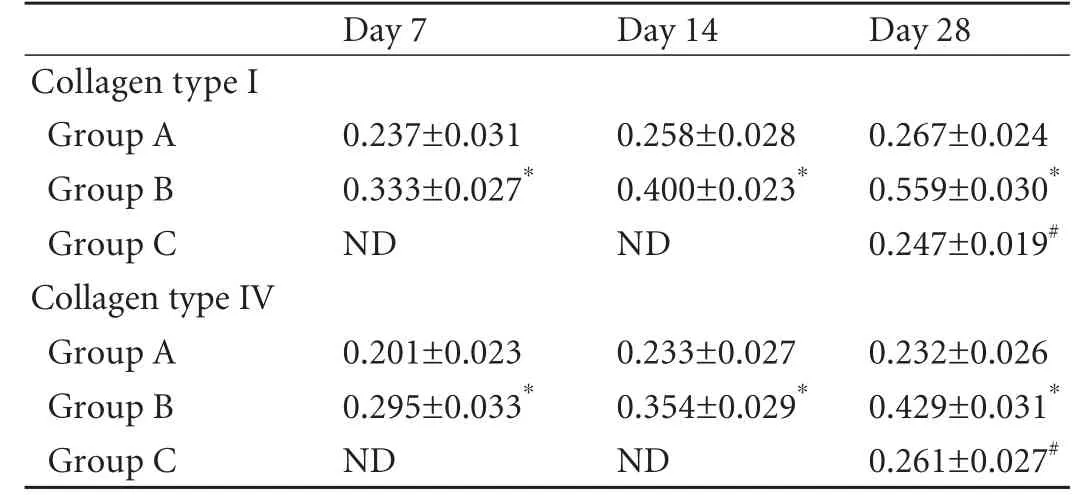
Table 1. Fluorescence content of collagen type I and type IV using indirect immunofluorescence staining

Fig. 1. To induce reversible cirrhosis. A: Animals were treated with phenobarbital and carbon tetrachloride. There was atrophy of the liver lobes with cirrhotic nodules ; B: all livers had extensive fibrosis, nodular regenerative hyperplasia and multiple nodules consistent with cirrhosis (HE, original magnification ×35); C: control normal liver tissue (HE, original magnification ×50).

Fig. 2. Indirect immunofluorescence analysis of collagen type I and type IV (original magnification ×20). Staining was performed using a monoclonal mouse anti-collagen type I or type IV antibody followed by a rabbit anti-mouse immunoglobulin/FITC secondary antibody. A-C: type I; a-c: type IV, group A (treated on day 7, 14 and 28, respectively). D-F: type I; d-f: type IV, group B (treated on day 7, 14 and 28, respectively). G: type I; g: type IV, group C (treated on day 28).
Immunofluorescence cytochemistry of cultured HSCs
When HSCs were activated, their morphology changed from round to spindle-shaped and α-SMA was expressed. Most HSCs displayed a myofibroblastlike phenotype and expressed α-SMA. These activated HSCs had typical morphological characteristics (Fig. 3). Our results demonstrated that more than 90% of the activated HSCs remained active in our culture conditions. The overwhelming majority of control cells were spindle-shaped and expressed α-SMA (Fig. 3A). HSCs administered GH still showed an activated phenotype with the spindle shape, and the majority had high α-SMA expression (Fig. 3B). IFN-γ-treated cells were smaller and had less α-SMA expression (Fig. 3C). Although used at the higher concentration (10-1μg/100 μL), cells co-administered IFN-γ and GH showed that INF-γ inhibited the cell shape transformation and α-SMA expression to a certain extent (Fig. 3D).
HSC proliferation
Recombinant human GH significantly stimulated HSC proliferation in a concentration-dependent manner, and IFN-γ inhibited HSC proliferation at concentrationsof 10-2-10-1μg/100 μL (Table 2 and Fig. 3). When combined with GH, IFN-γ eliminated the proliferationpromoting effect of GH on HSCs to a certain degree (10-1μg/100 μL IFN-γ,t=3.077,P<0.05) (Table 3). However, treatment with 10-3μg/100 μL and 10-2μg/100 μL IFN-γ did not show any statistically significant effect (t=1.831; 0.254, respectively, bothP>0.05). The optical density (OD) values values of activated HSCs treatedwith different concentrations of IFN-γ 24 hours after treatment with GH showed a weaker inhibitory effect than those treated with GH co-administered with IFN-γ (t=2.581,P<0.05) (Table 3 and Fig. 4).
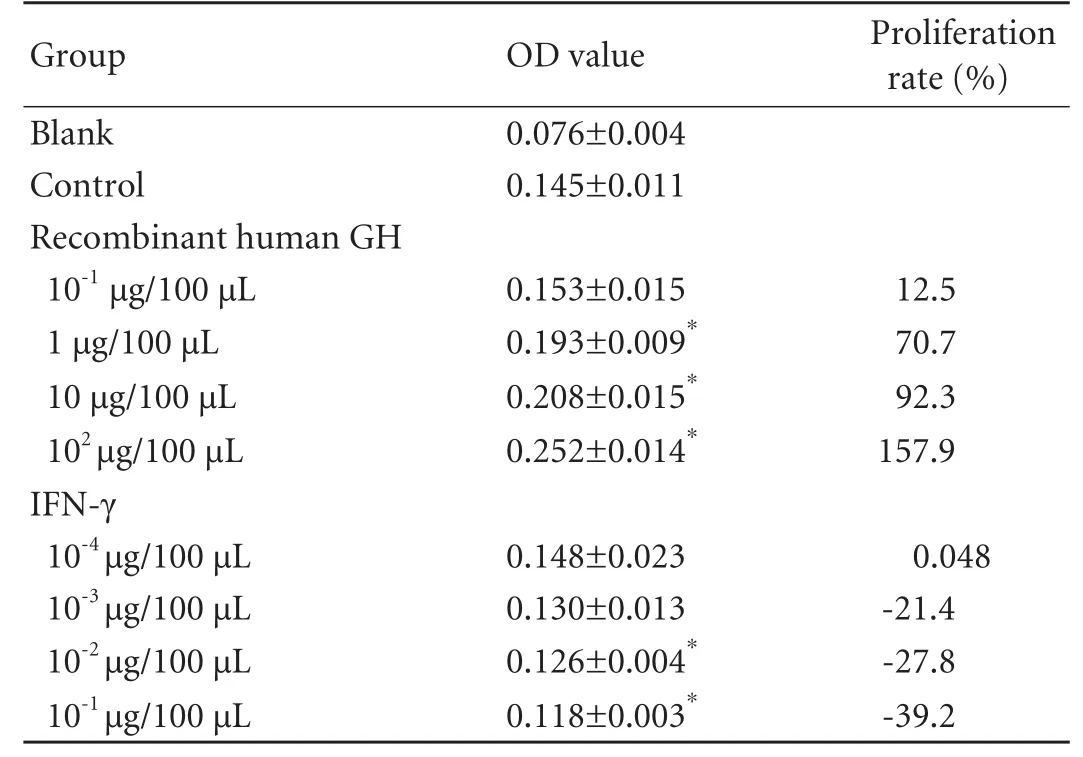
Table 2. Proliferative effect of recombinant human GH or IFN-γ on activated HSCs (MTT assay)
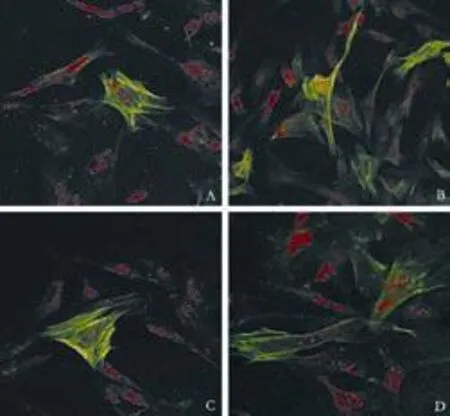
Fig. 3. Morphology and expression of α-SMA in cultured HSCs (original magnification ×400). Staining was performed using monoclonal mouse anti-SMA antibody followed by rabbit antimouse immunoglobulin/FITC secondary antibody. The red fluorescence delineates myofibroblast-like cells, while the expression of α-SMA in the same cell is indicated by the green fluorescence. A: Control; B: recombinant human GH (102μg/100 μL)-treated cells; C: IFN-γ (10-1μg/100 μL)-treated cells; D: recombinant human GH (102μg /100 μL) combined with IFN-γ (10-1μg/100 μL)-treated cells.
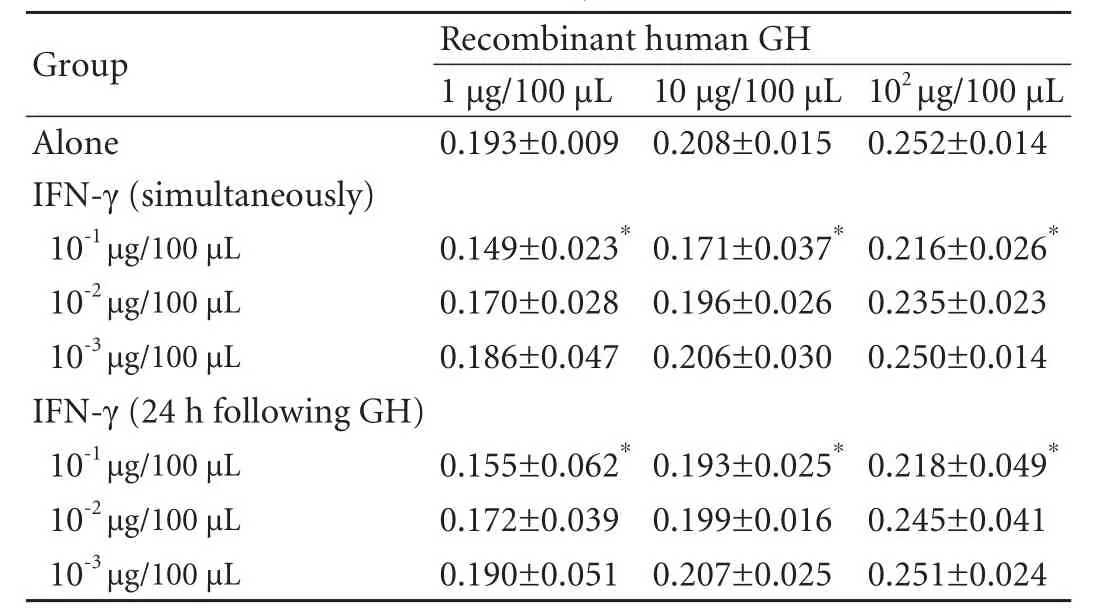
Table 3. OD values of HSCs incubated with IFN-γ combined with recombinant human GH (MTT assay)
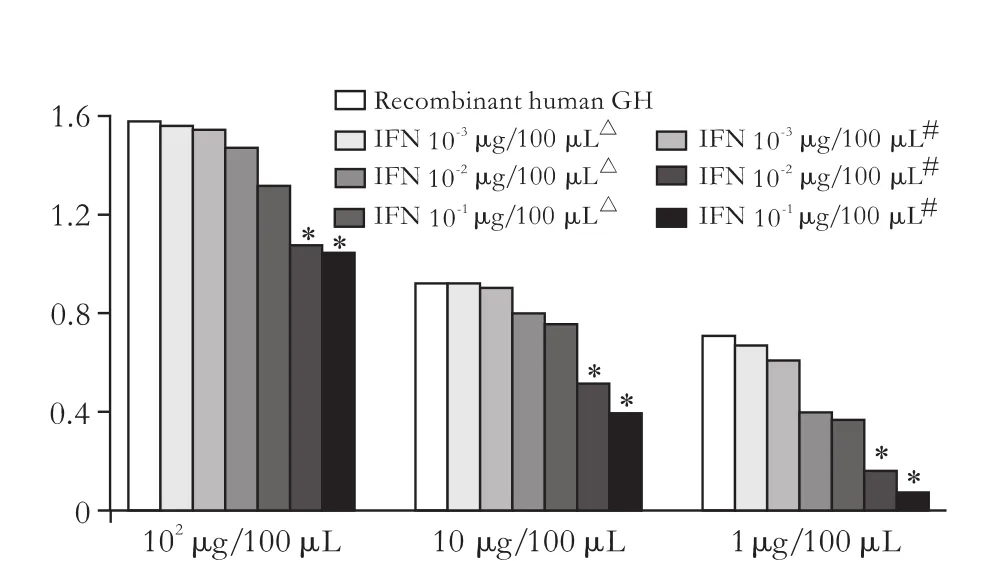
Fig. 4. Proliferation rates with recombinant human GH combined with IFN-γ in activated HSCsin vitro. MTT assay: activated HSCs from cirrhotic rats were treated with different concentrations of IFN-γ combined with recombinant human GH. △: Cells treated with IFN-γ followed by recombinant human GH 24 hours later. #: Cells treated with recombinant human GH co-administered with IFN-γ. *:P<0.05, compared with recombinant human GH alone.
Discussion
Liver fibrosis, thought to be a dynamic process in which fibrogenic and fibrinolytic pathways co-exist and interact, results from excessive accumulation of ECM proteins secreted from cells of the fibroblast lineage during chronic liver injury.[24]Morphologically and functionally different hepatocyte populations are involved in this process, in particular activated HSCs and liver myofibroblasts.[25,26]HSCs undergo a phenotypic transition bothin vivoandin vitrofrom a quiescent phenotype to a myofibroblast-like phenotype (activated HSCs) that has high proliferative and fibrogenic abilities.[27,28]HSCs are considered one of the key effectors of the fibro-proliferative response in the liver.[28,29]
The classical indication for GH therapy is GH deficiency, where it is administered in substitutional doses. However, there is a growing interest in using pharmacological doses of GH for catabolic patients, e.g., patients with burns, chronic renal failure, chronic obstructive pulmonary disease and myocardial infarction, all of whom may benefit from the anabolic effects of this therapy.[30]Recent reports have demonstrated improved liver function induced by GH administration.[7-9]Whether GH replacement therapy promotes fibrosis is controversial.[31,32]As shown in previous studies, GH administration significantly promotes collagen content and new collagen accretion.[10-12]However, several independent groups have demonstrated an effect of attenuation of interstitial fibrosis in the skeletal and cardiovascular systems.[13,14]Systemically, these studies are limited to extra-hepatic tissue and organs. Similar to previous reports,[10-12,32]the promotion of collagen genesis by GH was found in the present study. In rats with carbon tetrachloride-induced liver cirrhosis which were given 28 days of recombinant human GH, we found that the relative content of both collagen type I and type IV, qualitatively as well as quantitatively, significantly increased with time. Moreover, we demonstrated that GH administration enhanced the proliferation of activated HSCs from rats with carbon tetrachlorideinduced liver cirrhosis.
We found that IFN-γ administration along with recombinant human GH inhibited the generation of collagen in carbon tetrachloride-induced liver cirrhosis. Moreover, whether combined with GH or administered by itself, IFN-γ eliminated the promoting effect of GH on cultured HSC proliferation in a concentrationdependent manner. Studies supported our findings in the literature.[33,34]In liver fibrosis, the administration of IFN-γ has been successfully implemented with few side-effects.[16]Thus, IFN-γ could inhibit the activation of HSCs. In our study, IFN-γ offset the proliferationinducing activity of GH on activated HSCs from carbon tetrachloride-induced liver cirrhosis rats and inhibited the generation of collagen.
GH has proliferative, inhibitory and metabolic effects, which potentially promote the proliferation of hepatic non-parenchymal cells through activating a complex signaling transduction cascade.[35]The proliferation and activation of hepatic non-parenchymal cells, especially HSCs,[36]are considered to play crucial roles in the development of liver fibrosis. Consistent with other reports, our findings demonstrated that GH administration enhanced the proliferation and activation of cultured HSCs and enhanced the morphological transdifferentiation of HSCs into myofibroblasts. The action of GH supplementation in cirrhosis is related to its effect on protein synthesis in the liver,[37]some of which is mediated through IGF-I signaling, especially the locally-generated IGF-I at the target sites.[30,38]Prior studies have revealed that high local concentrations of IGF-I trigger DNA synthesis and proliferation in activated HSCs isolated from rat liver.[39]It is believed that the chemotactic, mitogenic and fibrogenic activities of IGF-I are regulated by GH and cytokines [e.g. transforming growth factor-α (TGF-α) and TGF-β] released from activated stellate cells.[40]Thus, we speculate that together with the functional properties of multiple growth factors released during chronic liver injury, GH administration might play a role in promoting the proliferation and biosynthesis of ECM components in HSCs during thedevelopment of liver fibrosis bothin vivoandin vitro. Further molecular studies are needed to elucidate the mechanism. This study indicates that IFN-γ is a potent inhibitor of collagen synthesis during the development of liver fibrosis through an inhibitory effect on HSC activation. The mechanisms whereby IFN-γ offsets thein vivofibrogenic effect of GH are not well understood. IFN-γ has been identified as an inhibitor of ECM synthesis by antagonizing TGF-β.[41]
There were two limitations of our study. First, we neglect to include an IFN-γ only groupin vivo. As previously reported,[16,33,34]the antifibrotic effect of IFN-γ has been well defined, and confirmed by our study. Second, our study mainly focused on the fibrogenic/ antifibrotic effect of recombinant human GH and IFN-γ on hepatic collagen synthesis and proliferation of HSCs in a cirrhotic rat model. Further analyses should focus on the intrahepatic levels of IGF-I, inflammatory cytokines (e.g. TGF and interleukin), and apoptosis in order to clarify the mechanism.
In conclusion, our results demonstrate that exogenous GH administered subcutaneously to rats with carbon tetrachloride-induced liver cirrhosis increased the production of collagen. In addition, recombinant human GH promoted the proliferation of activated HSCs from rats with carbon tetrachloride-induced liver cirrhosisin vitro. Finally, IFN-γ given simultaneously with recombinant human GH might offset these effects. Further molecular studies are needed to elucidate the mechanism.
Acknowledgements: We thank Dr. Yan-Rong Lu (Key Laboratory of Transplant Engineering and Immunology, West China Hospital, Sichuan University, Chengdu, China) for skillful technical assistance.
Contributors: All allthors designed the research. CYH, DBQ and ZZJ performed experiments. CYH and XGM contributed new reagents/analytic tools. CYH, LXB and MG analyzed the data; and CYH, LXB and MG wrote the paper. MG is the guarantor.
Funding: None.
Ethical approval: The study was approved by the Ethical Guidelines Committee of Sichuan University.
Competing interest: No benefits in any form have been received or will be received from a commercial party related directly or indirectly to the subject of this article.
1 Shepherd RW, Chin SE, Cleghorn GJ, Patrick M, Ong TH, Lynch SV, et al. Malnutrition in children with chronic liver disease accepted for liver transplantation: clinical profile and effect on outcome. J Paediatr Child Health 1991;27:295-299.
2 Crawford DH, Cuneo RC, Shepherd RW. Pathogenesis and assessment of malnutrition in liver disease. J Gastroenterol Hepatol 1993;8:89-94.
3 Chin SE, Shepherd RW, Thomas BJ, Cleghorn GJ, Patrick MK, Wilcox JA, et al. Nutritional support in children with end-stage liver disease: a randomized crossover trial of a branched-chain amino acid supplement. Am J Clin Nutr 1992;56:158-163.
4 Donaghy A, Ross R, Gimson A, Hughes SC, Holly J, Williams R. Growth hormone, insulinlike growth factor-1, and insulinlike growth factor binding proteins 1 and 3 in chronic liver disease. Hepatology 1995;21:680-688.
5 Donaghy AJ, Delhanty PJ, Ho KK, Williams R, Baxter RC. Regulation of the growth hormone receptor/binding protein, insulin-like growth factor ternary complex system in human cirrhosis. J Hepatol 2002;36:751-758.
6 Blaas L, Kornfeld JW, Schramek D, Musteanu M, Zollner G, Gumhold J, et al. Disruption of the growth hormone--signal transducer and activator of transcription 5--insulinlike growth factor 1 axis severely aggravates liver fibrosis in a mouse model of cholestasis. Hepatology 2010;51:1319-1326.
7 Wallace JD, Abbott-Johnson WJ, Crawford DH, Barnard R, Potter JM, Cuneo RC. GH treatment in adults with chronic liver disease: a randomized, double-blind, placebo-controlled, cross-over study. J Clin Endocrinol Metab 2002;87:2751-2759.
8 Li N, Zhou L, Zhang B, Dong P, Lin W, Wang H, et al. Recombinant human growth hormone increases albumin and prolongs survival in patients with chronic liver failure: a pilot open, randomized, and controlled clinical trial. Dig Liver Dis 2008;40:554-559.
9 Cao J, Luo SM, Liang L, Lai J. Effects of parenteral nutrition without and with growth hormone on growth hormone/ insulin-like growth factor-1 axis after hepatectomy in hepatocellular carcinoma with liver cirrhosis. JPEN J Parenter Enteral Nutr 2007;31:496-501.
10 Kyparos A, Orth MW, Vailas AC, Martinez DA. Growth and maturational changes in dense fibrous connective tissue following 14 days of rhGH supplementation in the dwarf rat. Growth Horm IGF Res 2002;12:367-373.
11 Bowers D, McKenzie D, Dutta D, Wheeless CR, Cohen WR. Growth hormone treatment after cesarean delivery in rats increases the strength of the uterine scar. Am J Obstet Gynecol 2001;185:614-617.
12 Rosén T. Supraphysiological doses of growth hormone: effects on muscles and collagen in healthy active young adults. Horm Res 2006;66:S98-104.
13 Moreira VO, Pereira CA, Silva MO, Felisbino SL, Cicogna AC, Okoshi K, et al. Growth hormone attenuates myocardial fibrosis in rats with chronic pressure overload-induced left ventricular hypertrophy. Clin Exp Pharmacol Physiol 2009; 36:325-330.
14 Santos DP, Okoshi K, Moreira VO, Seiva FR, Almeida FL, Padovani CR, et al. Growth hormone attenuates skeletal muscle changes in experimental chronic heart failure. Growth Horm IGF Res 2010;20:149-155.
15 Chen M, Wang GJ, Diao Y, Xu RA, Xie HT, Li XY, et al. Adeno-associated virus mediated interferon-gamma inhibits the progression of hepatic fibrosisin vitroandin vivo. World J Gastroenterol 2005;11:4045-4051.
16 Weng HL, Wang BE, Jia JD, Wu WF, Xian JZ, Mertens PR, et al. Effect of interferon-gamma on hepatic fibrosis in chronic hepatitis B virus infection: a randomized controlled study. Clin Gastroenterol Hepatol 2005;3:819-828.
17 Gressner OA, Weiskirchen R, Gressner AM. Evolving concepts of liver fibrogenesis provide new diagnostic andtherapeutic options. Comp Hepatol 2007;6:7.
18 Kisseleva T, Brenner DA. Role of hepatic stellate cells in fibrogenesis and the reversal of fibrosis. J Gastroenterol Hepatol 2007;22:S73-78.
19 Proctor E, Chatamra K. Standardized micronodular cirrhosis in the rat. Eur Surg Res 1984;16:182-186.
20 Regimbeau JM, Fuks D, Kohneh-Shahri N, Terris B, Soubrane O. Restrictive model of compensated carbon tetrachloride-induced cirrhosis in rats. World J Gastroenterol 2008;14:6943-6947.
21 Lee KS, Buck M, Houglum K, Chojkier M. Activation of hepatic stellate cells by TGF alpha and collagen type I is mediated by oxidative stress through c-myb expression. J Clin Invest 1995;96:2461-2468.
22 Rockey DC, Housset CN, Friedman SL. Activation-dependent contractility of rat hepatic lipocytes in culture andin vivo. J Clin Invest 1993;92:1795-1804.
23 Alley MC, Scudiero DA, Monks A, Hursey ML, Czerwinski MJ, Fine DL, et al. Feasibility of drug screening with panels of human tumor cell lines using a microculture tetrazolium assay. Cancer Res 1988;48:589-601.
24 Ramadori G, Saile B. Portal tract fibrogenesis in the liver. Lab Invest 2004;84:153-159.
25 Knittel T, Kobold D, Saile B, Grundmann A, Neubauer K, Piscaglia F, et al. Rat liver myofibroblasts and hepatic stellate cells: different cell populations of the fibroblast lineage with fibrogenic potential. Gastroenterology 1999;117:1205-1221.
26 Cassiman D, Libbrecht L, Desmet V, Denef C, Roskams T. Hepatic stellate cell/myofibroblast subpopulations in fibrotic human and rat livers. J Hepatol 2002;36:200-209.
27 Saile B, Ramadori G. Inflammation, damage repair and liver fibrosis--role of cytokines and different cell types. Z Gastroenterol 2007;45:77-86.
28 Friedman SL. Molecular regulation of hepatic fibrosis, an integrated cellular response to tissue injury. J Biol Chem 2000;275:2247-2250.
29 Friedman SL, Bansal MB. Reversal of hepatic fibrosis -- fact or fantasy? Hepatology 2006;43:S82-88.
30 Mauras N, Haymond MW. Are the metabolic effects of GH and IGF-I separable? Growth Horm IGF Res 2005;15:19-27.
31 Lal SO, Wolf SE, Herndon DN. Growth hormone, burns and tissue healing. Growth Horm IGF Res 2000;10:S39-43.
32 Doessing S, Heinemeier KM, Holm L, Mackey AL, Schjerling P, Rennie M, et al. Growth hormone stimulates the collagen synthesis in human tendon and skeletal muscle without affecting myofibrillar protein synthesis. J Physiol 2010;588:341-351.
33 Baroni GS, D'Ambrosio L, Curto P, Casini A, Mancini R, Jezequel AM, et al. Interferon gamma decreases hepatic stellate cell activation and extracellular matrix deposition in rat liver fibrosis. Hepatology 1996;23:1189-1199.
34 Shen H, Zhang M, Minuk GY, Gong Y. Different effects of rat interferon alpha, beta and gamma on rat hepatic stellate cell proliferation and activation. BMC Cell Biol 2002;3:9.
35 Greenhalgh CJ, Alexander WS. Suppressors of cytokine signalling and regulation of growth hormone action. Growth Horm IGF Res 2004;14:200-206.
36 Moreira RK. Hepatic stellate cells and liver fibrosis. Arch Pathol Lab Med 2007;131:1728-1734.
37 Reuber MD. Effect of growth hormone on hepatic carcinogenesis and cirrhosis in AxC rats given N-2 fluorenyldiacetamide. Cancer Res 1968;28:2177-2179.
38 Butler AA, Le Roith D. Control of growth by the somatropic axis: growth hormone and the insulin-like growth factors have related and independent roles. Annu Rev Physiol 2001; 63:141-164.
39 Saile B, DiRocco P, Dudas J, El-Armouche H, Sebb H, Eisenbach C, et al. IGF-I induces DNA synthesis and apoptosis in rat liver hepatic stellate cells (HSC) but DNA synthesis and proliferation in rat liver myofibroblasts (rMF). Lab Invest 2004;84:1037-1049.
40 Kmie? Z. Cooperation of liver cells in health and disease. Adv Anat Embryol Cell Biol 2001;161:III-XIII, 1-151.
41 Rockey DC, Maher JJ, Jarnagin WR, Gabbiani G, Friedman SL. Inhibition of rat hepatic lipocyte activation in culture by interferon-gamma. Hepatology 1992;16:776-784.
April 30, 2011
Accepted after revision November 17, 2011
Author Affiliations: Department of Hepatobiliopancreatic Surgery, West China Hospital, Sichuan University, Chengdu 610041, China (Chen YH, Du BQ, Zheng ZJ, Xiang GM, Liu XB and Mai G)
Gang Mai, MD, Department of Hepatobiliopancreatic Surgery, West China Hospital, Sichuan University, Chengdu 610041, China (Tel: 86-28-85422477; Fax: 86-28-85164035; Email: maigang68@hotmail. com)
? 2012, Hepatobiliary Pancreat Dis Int. All rights reserved.
10.1016/S1499-3872(12)60163-5
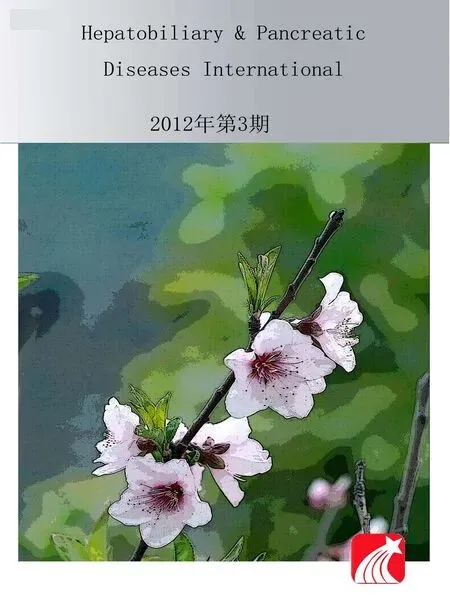 Hepatobiliary & Pancreatic Diseases International2012年3期
Hepatobiliary & Pancreatic Diseases International2012年3期
- Hepatobiliary & Pancreatic Diseases International的其它文章
- Management of splenic artery aneurysm associated with extrahepatic portal vein obstruction
- Pancreas-preserving segmental duodenectomy for gastrointestinal stromal tumor of the duodenum and splenectomy for splenic angiosarcoma
- Induction, modulation and potential targets of miR-210 in pancreatic cancer cells
- Quantitative analysis of intestinal gas in patients with acute pancreatitis
- Can the biliary enhancement of Gd-EOB-DTPA predict the degree of liver function?
- Quality control measures for lowering the seroconversion rate of hemodialysis patients with hepatitis B or C virus
